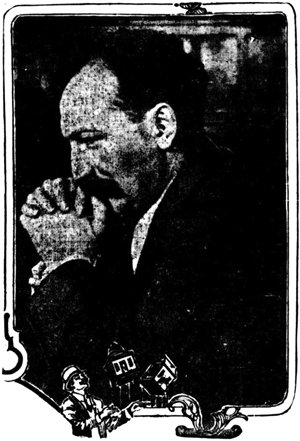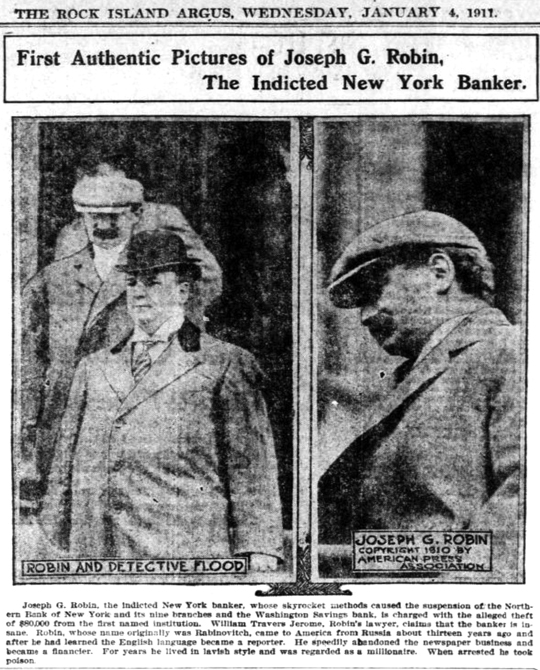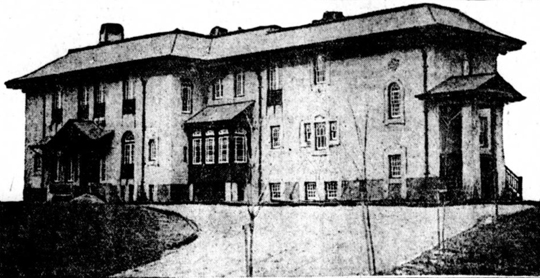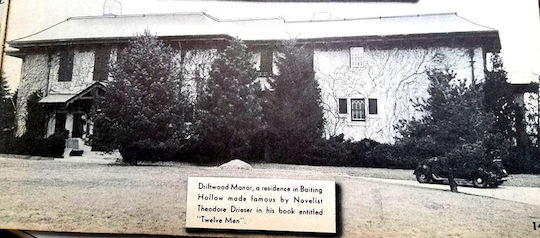putterings 455 < 455a > 455b index
Robin / Robinovitch; being geniuses together
- summary and introduction
- sources about Joseph G. Robin
- before the fall (pre 1911 sightings)
- writings by Joseph G. Robin (Jay Robin, Odin Gregory, pseuds.)
- Joseph G. Robin in literature about “bank-wreckers” and Theodore Dreiser
- Louise G. Robinovich : sources about, and writings by (separate page)
![]()
summary and introduction
This page lists and provides some extracts from material by and about Joseph G. Robin (1876-1929) and his sister Louise G. Robinovitch (1869-1954). Robin gains fame and eventually notoriety for his rapid amassing of wealth. His name Robin is one he adopted; he lets it be understood that he is French. There are various accounts of his start : shining shoes, working in his father’s bakery, newspaper work, selling a story (on improprieties in New York’s insane asylums, presumably using findings of his sister) that yield seed money of $500. This he eventually manages to parlay into ownership of banks, real estate and transportation interests. His fame extends to Driftwood Manor — his mansion, and the goings-on there — at Riverhead, Long Island. It all unravels in December 1910 and early 1911. After prison (in the Tombs), he vanishes, only to surface in 1920 (and 1923) when two verse plays are published, one prefaced by Theodore Dreiser. Robin is almost certainly the author of an earlier book, The flight of Icarus; an idyl of Printing-house square (1898), referred to in Dreiser’s thinly-disguised profile of Robin in his Twelve Men (1919).
Robin dies of a heart attack in 1929 (a few months short of the stock market crash).
Joseph G. Robin’s relationship with his sister Louise, and her own career as a physician and medical/physiological researcher/scientist, are also covered on this and a subsequent page (455c).
That relationship is an interesting story — or mystery — on its own. Louise Robinovitch studies medicine in France and later Philadelphia. Her interests can be traced through her publications : blood coagulation (1889); abstracts of medical and related literature (beginning in 1890 and continuing for nearly 20 years); morphine addiction; criminality and alcoholism; uses of electricity in medical treatments (as an anaesthetic in what was called “electric sleep,” and also to revive life after death — for which she had some fame ca 1908-1909); her The Journal of Mental Pathology (1901-09; for which she was sole editor); some work in the early 1920’s on the chemical treatment of tuberculosis; even some patents (as assignee). Her articles in The Journal of Mental Pathology were not peer-reviewed, and in addition to the topics just mentioned, concerned genius, eugenics, and even the effects of electrocution. That journal also provided a pulpit in its editorials, on topics that included the mind of the assassin, management of insane asylums, and testimony of medical experts on behalf of either defense or prosecution.
I surmise that Louise G. Robinovitch saw her brother as a genius (there was another brother, of whom nothing (?) is known). Both were literary; he as a writer, she in which cases play a sometimes large role in her articles. Louise’s Journal of Mental Pathology was almost certainly underwritten by her brother, and ended with the collapse of his castle built on sand. The two swapped assets when convenient to either of their interests. Their rejection of the two persons who claimed (probably legitimately) to be their parents also fits (somehow, I feel) into Louise’s theory of genius and a certain notion of being a self-made man or woman.
Her change of spelling from Rabinovitch to Robinovitch would surely have been to distance herself from Jewish identity. Joseph’s Jesus ; The tragedy of man (1923), written under the pseudonym of Odin Gregory, was charged by one critic as being anti-Semitic; the term “self-hating Jew” comes to mind (wikipedia).
I theorize that Louisa’s career as a psychologist ends when funding of her journal ends; an indictment for perjury in 1911 likely also plays a part. And yet there will a subsequent chapter to her career and life.
![]()
contemporary and recent material on Joseph G. Robin.
- “Joseph G. Robin, Real ‘Frenzied Financier,’ Now Facing a Jury”

San Antonio Light and Gazette 32:37 (February 27, 1911) : 1
via LoC’s Chronicling America : linknote inset figure, juggling bank buildings ?
- “Discovering Joseph G. Robin,” parts 1 and 2, at Claudia Keenan her Through the Hourglass blog :
link (June 3, 2022) and
link (July 6, 2022)These two blog posts offer a good overview of Joseph G. Robin’s career. They might appear in a sequel to her 2020 collection, Waking Dreamers, Unexpected American Lives: 1880-1980 : amazon.
- the fullest account I can find of Robin’s earlier career is :
“Bank Owner Began on a Shoe-string; With less than $500 Robin, born Robinovitch, bought a million-dollar company; Then sold out at a profit; Got into real estate and presently had his own chain of banks — Career began with selling a scandal”
The New York Times (December 28, 1910) : 2
link (pay-walled)a transcription of that profile is at 455a
- That profile accompanies a very long investigative piece on closure of the Northern Bank —
“[State Bank Superintendent] Cheney Shuts Northern Bank; Shortage found in Harlem concern due to manipulations by J. G. Robin; He is in a sanitarium; Aetna Indemnity Company and Rochester Title and Guarantee Company involved; The bank may be solvent/ Counsel declares that its fudns are not impaired, but State Officials are reticent; Methods like Morse’s; Robin as Head of Bank Executive Committee shifted securities to get cash; Associated with Heinze; Used many copper securities in exchange for more easily negotiable stocks”
The New York Times (December 28, 1910) : 1-2
link and link (pay-walled) - “Banker Robin Scoffs at Aged Couple Who Call Him Son;
Old Folks Mourn With Grief as He Turns Back; Tangle Hurried Lexow’s Death.”
The Rocky Mountain News 52:6 (January 6, 1911) : 12
via Colorado Historic Newspapers Collection : linktranscription at 455b
- “Pen Sketches of World Celebrities;
Millions from Nothing
Story of Robin, New York’s frenzied financier, who disowned his parents.” The Rocky Mountain News 52:11 (January 11, 1911) : 12
via Colorado Historic Newspapers Collection : linktranscription at 455b
- “First Authentic Pictures of Joseph G. Robin, The Indicted New York Banker.”

Rock Island Argus (Illinois; January 04, 1911) : 4
via LoC’s Chronicling America : link - “Robin Admits $27,000 Theft
Fallen banker startles court with plea of guilty.
Jerome retires from case
‘Tired of Fooling,’ says prisoner lawyer sought to prove insane.”
The Rocky Mountain News 52:61 (March 2, 1911) : 10
via Colorado Historic Newspapers Collection : linkNEW YORK, March 1. — Joseph G. Robin, the fallen banker, pleaded guilty today to an indictment charging him with the larceny of $27,000 from the Washington Savings bank of which he was formerly president. Seven indictments against him remain. He was remanded to the Tombs until March 27, when he will be sentenced.
The collapse of Robin’s defense of insanity put forward by his sister, Dr. Louise Robinovitch. and his counsel, William Travers Jerome, was foreshadowed last night, when it was reported that Robin said he was “tired of all this fooling,” but it caused a stir in the courtroom, none the less.
On the day he was arrested Robin attempted suicide on the way to court by swallowing poison but the prompt use of a stomach pump saved him.
On the motion of Jerome physicians were appointed by the state and defense to examine his sanity and they reported unanimously that he was incompetent to undertake a defense. A jury, sitting under Judge Swann, rejected the findings of the alienists and Judge Swann complimented the jury on its “horse sense.”
The case came to trial on Monday and Jerome’s preliminary motions to dismiss on the ground that the defendant was insane were overruled by Justice Seabury. Then Jerome decided to withdraw from the defense and Robin, through other counsel, pleaded guilty.
Robin, on his plea of guilty, may be given an indeterminate sentence of not less than five years and not more than ten years.
Within the next few days District Attorney Whitman will question Robin about the share of others, not under indictment, in the collapse of the banks with which he was connected. It is understood the prisoner has professed willingness to talk freely and he has already said that persons high in authority were as guilty as he. - “Sentenced to Serve Year in Penitentiary
Robin, Pleading Guilty to Theft of $127,000 From Bank, Gets Off Easy
Clemency shown for aiding in conviction of Cummims [sic], Reichman and Hyde”
The Bridgeport Evening Farmer (January 10, 1913) : 12
LoC’s Chronicling America : linkfull transcription at 455b
- “Joseph G. Robin Dies Suddenly; Heart attack follows motor ride — companion finds body — squire acts”
(no reference to his career)
The Daily Press (White Plains, N.Y., April 8, 1929)
via NYS Historic Newspapers : linkJoseph G. Robin, 53, was found dead lying on the bedroom floor in his apartment at 254 Marine avenue, about 6:30 p.m. yesterday by Miss Helen S. Jones, a friend, and Oswald Laska, superintendant of the building, whom Miss Jones had summoned when Robin failed to answer her knocks.
Robin and Miss Jones had been motoring during the day and returned to the apartment at 6:15 p.m. Robin complained of feeling ill and asked Miss Jones to take the car to a garage on Mamaroneck avenue. She returned in abou ten minutes and found the door locked. She called for help when Robin did not answer.
Mr. Laska called Dr. J. K. McDonald who pronounced the man dead. Dr. A. O. Squire, County Medical Examiner, was notified and ordered the body removed to an undertaking parlor. After an examination and talking with Miss Jones, he returned a verdit of death due to myocarditis, a weak condition of the heart.
The police were also notified and Sergeant Schmidt and Officer Sullivan went to the apartment. Police are holding the auto until relatives of Mr. Robin are located.
Miss Jones lives at 43 East 50 street, New York City. - Theodore Dreiser. “‘Vanity, Vanity,’ Saith the Preacher” in his Twelve Men (1919) : 263-288
U California copy/scan (one of several, via hathitrust) : linkThis (fascinating) profile is known to be of Joseph G. Robin; Dreiser seems to have been quite impressed by the artfully impressive building and scene. The account mentions Robin’s sister (an “ovitch” tacked onto the name); and is plausibly (or not) sympathetic to Robin’s charge that powerful New York business forces plotted to remove him from the picture.
- “Palace of Bank Wrecker Robin is Valued at Million and a Half”

Driftwood manor, the magnificent mansion at Wading River, Long Island, which was built by Joseph G. Robin, the New York banker, indicted on a charge of wrecking the Nothern Bank of New York. The mansion is valued at $500,000 and the property on which it lies $1,000,000. All the interior effects, tapestries and other art decorations, for which the banker squandered thousands, are being taken from the mansion and placed in the home of his sister in New York. In January last year Robin apparently grew tired of the place and deeded it over to his sister.
The deed was recorded on December 28, two days before the crash of the Northern Bank of New York, and it is believed that this last bit of financial wisdom will place about $1,000,000 worth of property beyond the reach of creditors.San Antonio Light & Gazette 31:360 (January 19, 1911) : 1
University of North Texas; Denton, TX copy/scan, via LoC’s Chronicling America : linkSee also Ray Larsen his account of of the property at
“Long Island History : The Estates that make up Wildwood State Park”
link
another photograph of Driftwood Manor appears as a banner top to that page —
the full jpeg can be viewed here : link
another image of Driftwood Manor, not as it was built but as envisioned in architect Palmer & Hornbostel’s preliminary renderings, is found at Robert B. MacKay, Anthony Baker and Carol S. Traynor, eds., Long Island country houses and their architects, 1860-1940 (1997) : 330-331
borrowable at archive.org : link

before the fall
some newspaper accounts of Joseph G. Robin, before his financial collapse in late December 1910.- “Grewsome [sic] Repast.
Thirteen Club Makes Merry Amid Human Skulls and Weird Surroundings.”
[Special to the Evening News.]
New York, June 14. — The Thirteen Club had its annual dinner last night. There were five tables with 13 at each table and in front of each guest there was a candle stuck in a baby’s skull. The ladies present at the dinner shivered at the sight and wondered where so many skulls were obtained.
The chief interest centered in the candle which would burn out first. It so happened the first to do so was at table three in front of a lady guest. Then the ladies at the dinner all looked ominously at each other. Over the chair of the president, F. C. Hamilton, was suspended an open umbrella bearing the club motto "Morituri te Salutamus." The first respect was paid to the memory of Capt. William Fowler, founder of the club, who died in his bed last year. He had present at the dinners for 15 years.
At the mock trial for heresy held after dinner Robert B. Waldo made an indictment against Joseph G. Robin, who acted as his own attorney, for having expressed delight and joy at seeing the moon over his right shoulder. The defendent was found guilty by 12 young women jurors, and was sentenced to eat 13 of the Thirteen Club’s dinners. There was no disagreeing, evidently among the juorors for they were back with their verdict in a hury and glad enough to get away.aside —
for an interesting piece on the Thirteen Club (and other social clubs of the time), see
Cara Giaimo, “The 1880s Supper Club That Loved Bad Luck;
How to remove the stigma from the number 13? Through a series of macabre dinner parties, of course.”
Atlas Obscura (April 25, 2017) : linkBuffalo Evening News (14 June 1899)
NYS Historic Newspapers : link- “Ontario Power Company”
Official announcement was made in New York yesterday that the control of the Niagara, Lockport & Ontario Power Company has passed to a new syndicate of capitalists headed by John J. Albright of that city and Mr. Westinghouse of the company.
The deal was closed yesterday, according to a dispatch received last night. Previous to the closing of this deal the interests now controlled by the new syndicate were vested in Joseph G. Robin and his associates and the Westinghouse company.
That the New York Central Railroad Company is interested in this latest move is evidenced by information given out officially in New York to the effect that the new syndicate in control of the Niagara, Lockport & Ontario Power Company’s affair represents a combination of the Westinghouse, Albright, New York Central and Vanderbilt interests as well as those of Horace E. Andrews of Cleveland and others.Medina Daily Journal (11 August 1905)
NYS Historic Newspapers : link- brief report, in a Lockport story —
Joseph G. Robin of New York, who financed the Niagara, Lockport & Ontario Power Company, and who last week sold his interests to the Westinghouse-Albright combination, has sent an interesting letter to Lockport. In it he extends his appreciation to people of Lockport for what support they gave given the enterprise.Buffalo Evening News (14 August 1905) NYS Historic Newspapers : link
- Joseph G. Robin, president of the Bank of Discount, the Bankers’ Realty and Security Company, and certain foreign interests, are the purchases of Morris Park racetrack, the sale of which was reported in the Evening Post on Wednesday.
The Evening Post (New York; 8 December 1905)
NYS Historic Newspapers : link- “Local News,” South Side Signal (Long Island, N.Y.; 17 August 1907)
NYS Historic Newspapers : linkWhile driving at a reckless rate of speed with his chauffeur in a Thomas flyer eastward along the country road in West Islip on Wednesday night Joseph G. Robin a well known New York banker and owner of the Morris Park Association property, lost control of his machine and collided with a tree in front of the Taylor place. The accident occurred shortly before 10 o’clock, Mr. Robin being on his way from New York City to Patchogue whither he was going to attend a hearing of the South Shore Traction Company before the Board of Trustees, in which corporation he is a holder of a large amount of stock and, realizing that he was late, was “letting her fly”, so the report comes to us. As the machine was going its mad pace a bit of sand was struck and Mr. Robin, who was steering the car, lost control of the apparatus which skidded and with awful force struck the tree. Mr. Robin and his chauffeur both escaped without a scratch not even being thrown from their seats, a special providence seemingly protecting those who take such foolhardy chances, but the machine was a complete wreck and was left by the road side until morning, when it was taken to Bay Shore for repairs. Had Mr. Robin killed himself the accident would have been deplorable, but how much more so if he had caused the death or maimed some innocent person. The country road should be policed at night as well as in the day. It is about time for the people to take some action that will prevent reckless night driving as well as speeding in the day time.

writings by Joseph G. Robin
- The flight of Icarus; an idyl of Printing-house square by “Jay Robin” (London and New York, F. T. Neely [1898])
Cornell copy/scan (via hathitrust) : linkmy reasons for believing this to be written by Joseph G. Robin are three:
1
In his “Vanity, Vanity” profile of “X” (who without a doubt Robin), Dreiser lets “Lucien de Shay, a ne’er-do-well pianist and voice culturist, who was also a connoisseur in the matter of rugs, hangings, paintings and furniture” and thus useful to “X,” introduce the narrator to that mysterious tycoon-in-the making —“And he isn’t dull. He wrote a book, at twenty, ‘Icarus,’ which is not bad either and which he says is something like himself. He has read your book (‘Sister Carrie’) and he sympathizes with that man Hurstwood. Says parts of it remind him of his own struggles...”
cited earlier, in his Twelve Men (1919) : 263-288 (266)
2
The book received a positive notice in the Medico-Legal Journal in 1899 : link
Louise Robinovitch is also named in that journal, same volume (pp392-393) : link.Indeed, this is the only significant review of The Flight of Icarus that I have so far found. Full transcription at 455b
3
I have now read the book, and am more certain that Robin is its author. The story evidences a keen familiarity with the newspaper business (both writing, editing, and even printing); a familiarity too with medicine, and mental hospitals (Bellevue, an asylum). There is a street-urchin newspaper office boy, one affectionately limned throughout, named “Joe.” All of this, and other details, recommend Joseph G. Robin as the author, possibly with editorial assistance, or at least first readings, by his sister Louise.
The novel is sentimental, but would offend polite readers of the time with its straightforward depiction of the demimondaine world, chorus girls, dissolute writers, drunks, mistresses, fallen women, corrupt police. One passage (among many) that bring Louise’s professional interests to mind comes in a conversation between John Revere, the saintly and decidedly obtuse idiot “hero” of the story, and Robert Keene, an intelligent observer of his own dissolute life. Keene has narrated his career to Revere, who —
“...was silent for a few moments.”
“‘Where is your will?’ he finally asked.”
“The stranger laughed.”
“‘The will,’ he replied, ‘is a pleasant fiction invented for the use of hypocrites. Once one plunges in the way I did, the will is of as much use as it is to a drunkard or morphine fiend. No, no, my dear friend, the road we travel closes up behind us as we progress. The only way to be safe is to keep out of it.’”
pp 163-164
see : Elaine G. Robinovitch’s discussion of the “striking” paper by G. Sergi his “The Newest Conception of Conscious and Will-Power” in her Journal of Mental Pathology 7:1 (1905), listed in my census of her writings in that journal at 455c
The copyright is held by its publisher. See
Catalogue of title entries of books and other articles entered in the Office of the Register of Copyrights, Library of Congress, at Washington, D.C. no.379-391 (1898) : 467
Harvard copy/scan (via hathtrust) : link- Caius Gracchus, a tragedy, by Odin Gregory [pseud.]
With an introduction by Theodore Dreiser.
New York, Boni and Liveright [1920].
LoC : permalink
LoC and other copies/scans via hathitrust : link
NYPL copy/scan (via google books) : link- Jesus ;The tragedy of man by Odin Gregory (pseudonym of Joseph G. Robin)
New York : Colony Pub. Co., [1923]
Ohio State U copy/scan (via google books) : link
same (via hathitrust) : linkan elaborate production; edition of five hundred copies printed by The Roycrofters (wikipedia).
scan does not show the single page (between copyright page and “Prefatory Notes”) indicating number of copies, of which the copy in hand is Number 70, below which is the signature of Odin Gregory.

- Jack E. Wallace. “The Comic Voice in Dreiser’s Cowperwood Narrative.” American Literature 53:1 (March 1981): 56-71
jstor : link- Thomas A. Mackay. “‘Bank-Wreckers, Defaulters, and Embezzlers’ : America’s Popular Fear and Fascination with the Misappropriation of Bank Deposits during the Gilded Age and Progressive Era.” Enterprise & Society 19:1 (March 2018) : 58-87
jstor : link
- “Grewsome [sic] Repast.
![]()
more can be found by searching for “odin gregory” and “Joseph G Robin” via NYS Historic Newspapers : link, and
LoC’s Chronicling America : link
30 August 2024